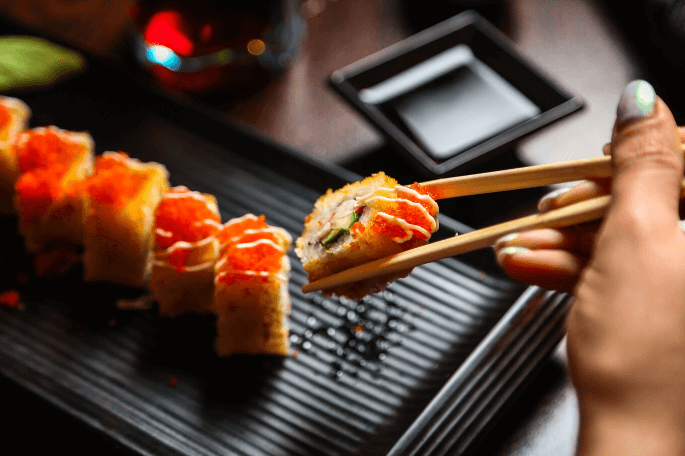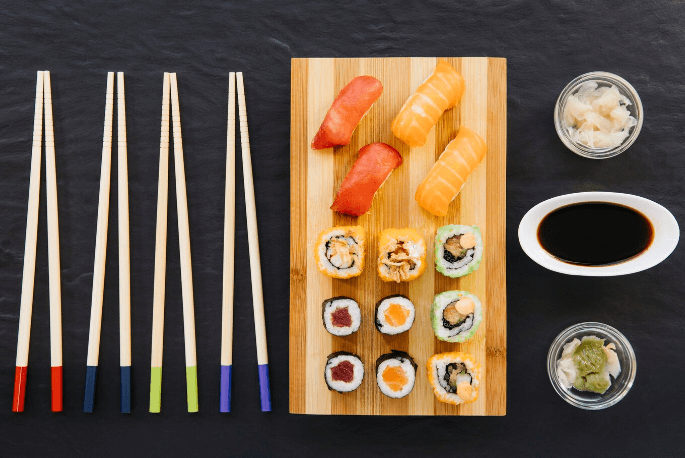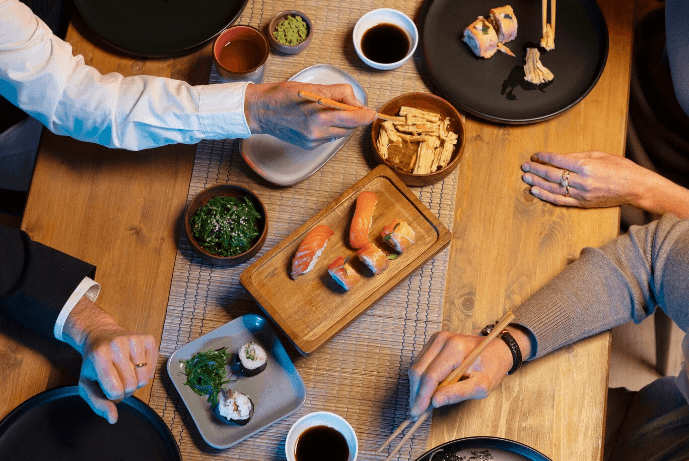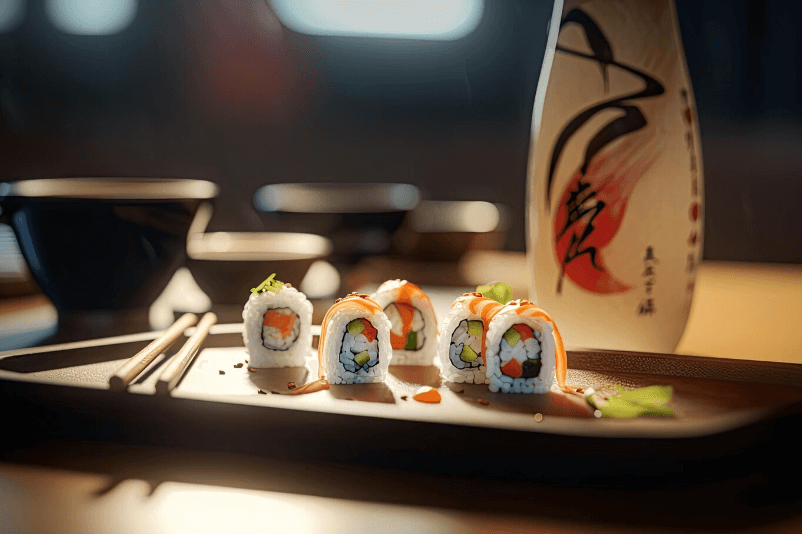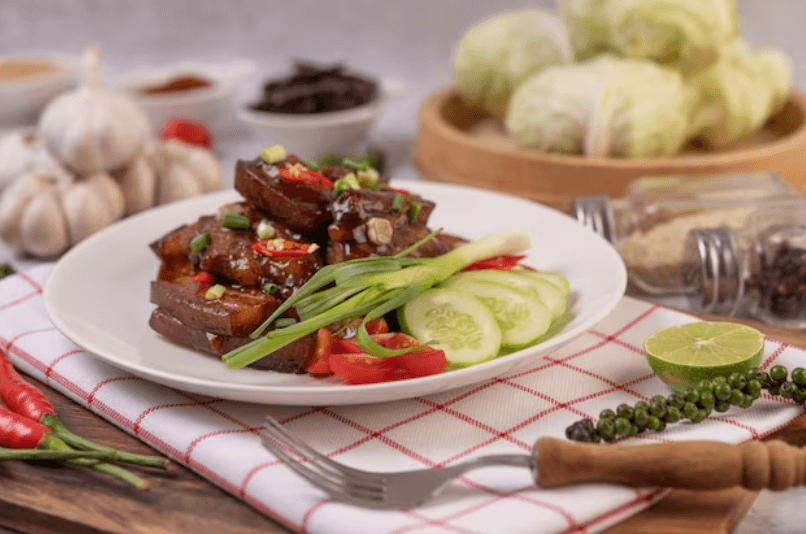Sushi Etiquette: Do’s and Don’ts
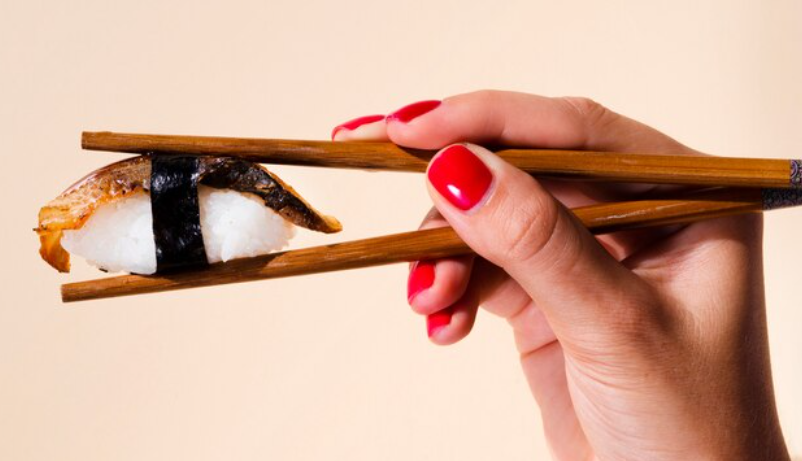
When it comes to enjoying sushi, there are certain do’s and don’ts that every sushi lover should be aware of. Sushi etiquette plays a crucial role in the overall experience of dining on this traditional Japanese cuisine. Following these guidelines will not only show respect for the chefs and cultural traditions, but also enhance your own enjoyment of the meal.
First and foremost, one of the most important do’s of sushi etiquette is to use your hands when eating sushi. While it may seem more natural to use chopsticks, sushi is traditionally eaten with the fingers. Using your hands allows you to feel the texture and temperature of the sushi, and it also helps to prevent the rice from falling apart. However, it’s important to note that using chopsticks is acceptable when eating sashimi or rolls.
Another important do of sushi etiquette is to dip the fish side of the nigiri into soy sauce, rather than dipping the rice. This is because soy sauce is meant to enhance the flavor of the fish, and dipping the rice can cause it to become too salty. Additionally, it’s best to dip the fish side lightly, as too much soy sauce can overpower the delicate flavors of the sushi.
On the other hand, there are a few don’ts in sushi etiquette that should be avoided. One of the biggest don’ts is rubbing or mixing wasabi into your soy sauce. The sushi chef has already carefully crafted the perfect balance of flavors, and adding extra wasabi can overpower the taste of the fish. Instead, if you prefer a stronger wasabi flavor, you can place a small amount directly on top of the fish before eating.
Finally, it’s important to avoid wasting food when enjoying sushi. Each piece of sushi is carefully crafted and prepared, and it’s considered rude to leave any sushi uneaten. If you’re unsure about a certain type of sushi, it’s best to order a smaller portion and try it first. And if you’re dining with others, it’s always polite to offer a piece of sushi to your dining companion if they express interest.
In conclusion, following sushi etiquette not only shows respect for the chefs and cultural traditions, but also enhances the overall dining experience. Remember to use your hands, dip the fish side into soy sauce, and avoid rubbing or mixing wasabi into your soy sauce. And most importantly, don’t waste any sushi, as each piece is carefully prepared and meant to be enjoyed.
History and Origins of Sushi
Sushi has a rich history and fascinating origins that date back centuries. This popular Japanese dish has evolved over time, and its etiquette plays a significant role in the overall sushi experience.
The roots of sushi can be traced back to Southeast Asia around the 4th century BC. Initially, it was developed as a way to preserve fish by fermenting it with rice. Over time, this fermentation process was refined, and the rice was no longer consumed. Instead, it served as a means of preserving the fish.
During the Muromachi period (1336-1573) in Japan, vinegar was introduced to the sushi-making process. The addition of vinegar allowed for faster fermentation, reducing the preparation time. This marked the shift from the original fermentation method to the more recognizable style of sushi we know today.
Sushi gained popularity in the 19th century during the Edo period. It was during this time that nigiri sushi, a hand-pressed style made with a small mound of rice topped with raw or cooked fish, became widely popular. The art of sushi-making continued to evolve, with various regional styles emerging.
As sushi became more widespread, proper sushi etiquette developed as well. Sushi etiquette involves respecting the chef, consuming sushi in one bite, using chopsticks correctly, and not dunking sushi rice into soy sauce. The do’s of sushi etiquette ensure a polite and enjoyable sushi experience for all.
Today, sushi has become a global sensation, enjoyed by people all over the world. Its history and origins remind us of the long journey this beloved dish has taken to reach our plates. So the next time you sit down to enjoy sushi, remember the rich heritage behind each bite.
Traditional Sushi Ingredients and Types
When it comes to sushi, there are certain traditional ingredients and types that you should be aware of to fully appreciate this Japanese delicacy. Understanding these components will not only enhance your dining experience, but also demonstrate proper sushi etiquette. Here are some do’s and don’ts when it comes to traditional sushi:
- Rice: Sushi rice is made from short-grain Japanese rice seasoned with vinegar, sugar, and salt. It serves as the foundation for most types of sushi.
- Fish: The most common type of fish used in sushi is tuna (maguro), followed by salmon (sake) and yellowtail (hamachi). Other popular options include mackerel (saba) and eel (unagi).
- Seafood: Sushi can also feature various types of seafood such as shrimp (ebi), squid (ika), octopus (tako), and crab (kani). Sea urchin (uni) and scallops (hotate) are considered delicacies.
- Vegetables: Sushi can include a variety of fresh vegetables such as cucumber (kappa), avocado, and pickled daikon radish. Seaweed (nori) is often used to wrap sushi rolls.
- Rolls: Sushi rolls, known as maki, are a popular type of sushi. They consist of a filling, such as fish or vegetables, wrapped in rice and seaweed. Examples of rolls include California roll, dragon roll, and spicy tuna roll.
- Nigiri: Nigiri sushi is a form of sushi where a slice of fish or seafood is placed on top of a small mound of rice. It is often served with a dab of wasabi between the fish and rice.
- Sashimi: Sashimi is thinly sliced raw fish or seafood served without rice. It is typically eaten with soy sauce and wasabi.
Knowing the traditional ingredients and types of sushi will help you make informed choices and appreciate the nuances of this culinary art. Remember to be respectful and adhere to sushi etiquette while enjoying your meal.
Proper Use of Chopsticks
When it comes to sushi etiquette, knowing the proper way to use chopsticks is essential. Here are some do’s and don’ts to keep in mind:
- Do hold the chopsticks towards the end, not in the middle or near the tip. This will give you better control and precision when picking up sushi.
- Don’t use your chopsticks to stab or spear the sushi. This is considered rude and disrespectful.
- Do use chopsticks to transfer sushi from the serving plate to your personal plate or directly to your mouth. Using your hands is generally not appropriate unless the sushi is too large or difficult to handle with chopsticks.
- Don’t cross your chopsticks or leave them standing upright in a bowl of rice. Both are considered bad luck and reminiscent of funeral rituals in Japanese culture.
- Do use chopsticks to separate sushi pieces if they are stuck together. However, avoid forcefully pulling them apart, as this may damage the sushi or make it fall apart.
- Don’t use your chopsticks to pick up food from shared dishes. Instead, use the communal serving utensils provided, or ask for a separate pair of chopsticks.
By following these do’s and don’ts, you will demonstrate respect for the sushi culture and enhance your dining experience. Enjoy your sushi!
Eating Sushi with Hands: When it’s Acceptable
When it comes to sushi etiquette, many people are unsure whether it’s acceptable to eat sushi with their hands. While using chopsticks is the most common way to enjoy sushi, there are certain situations where eating sushi with your hands is perfectly acceptable.
Sushi is traditionally eaten with the fingers in Japan, so it’s important to be aware of the cultural context. If you find yourself in a traditional sushi restaurant in Japan, it is generally acceptable to eat sushi with your hands. However, it’s important to observe the behavior of those around you to ensure you are following the proper etiquette.
Another situation where eating sushi with your hands is acceptable is when eating nigiri sushi. Nigiri sushi is a type of sushi that consists of a small mound of rice topped with a slice of fish or seafood. The proper way to eat nigiri sushi is to dip a small amount of soy sauce on the fish or seafood side, and then pick up the sushi with your fingers and eat it in one bite.
However, it’s important to note that not all types of sushi are meant to be eaten with your hands. For example, sushi rolls, also known as makizushi, are usually eaten with chopsticks. Sashimi, which is thinly sliced raw fish or seafood served without rice, should also be eaten with chopsticks.
Ultimately, the choice of whether to eat sushi with your hands or with chopsticks depends on the specific situation and your personal preference. Just remember to be respectful and observe the behavior of those around you to ensure you are following the proper sushi etiquette.
Soy Sauce and Wasabi: The Correct Way to Use Them
When it comes to enjoying sushi, there are certain dos and don’ts that you should be aware of. One important aspect of sushi etiquette is understanding the correct way to use soy sauce and wasabi.
Firstly, it’s important to know that soy sauce is typically used to enhance the flavors of sushi. However, it’s essential not to drown your sushi in soy sauce. Instead, you should lightly dip the fish side of the sushi into the soy sauce, making sure not to soak the rice. This will ensure that you can still taste the delicate flavors of the sushi while adding a touch of umami.
Secondly, when it comes to wasabi, it’s important to use it sparingly. Wasabi is a green paste that is made from the Japanese horseradish plant. It has a strong and spicy flavor that can easily overpower the taste of sushi. Therefore, you should only use a small amount of wasabi and mix it into your soy sauce to create a flavorful dipping sauce.
In addition, it’s important to avoid applying the wasabi directly onto the sushi. This is considered a sushi etiquette faux pas, as it can disrespect the chef’s artistry and compromise the taste of the sushi. Instead, mix a small amount of wasabi into your soy sauce and use it as a dip for each piece of sushi.
By following these guidelines, you can ensure that you are using soy sauce and wasabi correctly when enjoying sushi. This will not only show respect for the traditional Japanese cuisine but also allow you to fully appreciate the flavors of the sushi.
Sushi Toppings: To Add or Not to Add?
When it comes to sushi, there are certain etiquette rules to follow. While adding toppings to your sushi might seem like a personal preference, there are some guidelines to consider. Here are some do’s and don’ts when it comes to sushi toppings:
- Do try different sushi toppings: Sushi offers a wide variety of toppings to choose from. Some popular options include tuna, salmon, yellowtail, and shrimp. Feel free to experiment and find your favorite combination.
- Don’t overload your sushi: While it’s tempting to pile on the toppings, it’s important not to overload your sushi. Adding too many toppings can overpower the delicate flavors of the sushi rice and fish.
- Do use wasabi and soy sauce sparingly: Wasabi and soy sauce can enhance the flavors of sushi, but it’s important to use them sparingly. Too much wasabi or soy sauce can overpower the taste of the sushi.
- Don’t mix wasabi into soy sauce: In traditional sushi etiquette, it is considered rude to mix wasabi into soy sauce. Instead, you can dab a small amount of wasabi directly on top of your sushi before dipping it into the soy sauce.
- Do try pickled ginger: Pickled ginger, or gari, is often served with sushi. It is meant to be eaten between different types of sushi to cleanse the palate. Take a small amount of ginger and enjoy it as a palette cleanser.
- Don’t use chopsticks for sashimi: Sashimi is often served without rice and is meant to be enjoyed with your hands. It is considered improper sushi etiquette to use chopsticks when eating sashimi.
Remember, sushi etiquette is important to ensure a respectful and enjoyable dining experience. By following these do’s and don’ts, you can enhance your sushi dining experience and show appreciation for the art of sushi making.
Nigiri vs. Sashimi: Understanding the Difference
When it comes to enjoying sushi, it’s important to understand the difference between nigiri and sashimi. While both are delicious, they are prepared and served in different ways, each with its own set of do’s and don’ts in sushi etiquette.
Nigiri is a type of sushi that consists of a small mound of vinegared rice topped with a slice of raw or cooked seafood. It is typically served with a dab of wasabi between the rice and the seafood, and sometimes garnished with a thin strip of seaweed called nori. To eat nigiri, it is recommended to pick it up with your fingers and dip the fish side into soy sauce, as dipping the rice can cause it to fall apart.
Sashimi, on the other hand, refers to thinly sliced raw seafood served without rice. It is meant to be enjoyed on its own, highlighting the natural flavors of the fish. Sashimi is typically presented on a plate or a wooden board, and it is customary to use chopsticks to pick up the slices. It is important to avoid dipping sashimi into soy sauce, as it can overpower the delicate flavors of the fish.
In sushi etiquette, it is considered polite to eat nigiri and sashimi in one bite, to fully experience the combination of flavors. It is also important to pace yourself and not rush through your meal, as sushi is meant to be savored and enjoyed. When dining with others, it is customary to wait for everyone to be served before starting to eat.
Understanding the difference between nigiri and sashimi is essential in sushi etiquette. By following these do’s and don’ts, you’ll be able to fully appreciate the flavors and textures of each type of sushi, enhancing your overall dining experience.
How to Order Sushi: Tips for Communicating with the Sushi Chef
When it comes to ordering sushi, it’s important to understand proper etiquette and to communicate effectively with the sushi chef. By following these tips, you can ensure a smooth and enjoyable dining experience.
1. Sit at the counter: If possible, choose to sit at the sushi counter. This allows you to directly interact with the sushi chef and observe their craftsmanship.
2. Greet the chef: Before placing your order, it’s polite to greet the sushi chef with a friendly “Hello” or “Konichiwa.” This helps establish a respectful and friendly atmosphere.
3. Ask for recommendations: If you’re unsure about what to order, don’t hesitate to ask the sushi chef for recommendations. They are knowledgeable about the freshest ingredients and can suggest dishes based on your preferences.
4. Order in moderation: Rather than ordering everything at once, try to pace yourself and order a few pieces at a time. This allows the sushi chef to focus on preparing each dish with care and ensures that your sushi is served at its freshest.
5. Use proper terminology: Familiarize yourself with common sushi terminology to effectively communicate your preferences. For example, you can request “Nigiri” for a piece of fish on rice or “Sashimi” for slices of raw fish without rice.
6. Be open to trying new things: Don’t be afraid to step out of your comfort zone and try new types of sushi. The sushi chef may offer seasonal or specialty items that are not on the menu, so be open to their suggestions.
7. Express your preferences: If you have any specific dietary restrictions or allergies, be sure to let the sushi chef know before placing your order. They can accommodate your needs and suggest suitable options.
8. Show appreciation: After enjoying your sushi, it’s customary to thank the sushi chef for their skill and artistry. A simple “Arigato gozaimasu” (Thank you very much) goes a long way in showing your gratitude.
By following these tips, you can effectively communicate with the sushi chef and have a memorable sushi dining experience.
Eating Sushi in a Group: Sharing and Proper Manners
When enjoying sushi in a group setting, it’s important to follow proper sushi etiquette to ensure a pleasant dining experience for everyone. Here are some do’s and tips to keep in mind:
- Share the sushi: Sushi is traditionally meant to be shared, so it’s customary to order a variety of rolls and nigiri and distribute them among the group.
- Use chopsticks: Unless otherwise indicated, it’s best to use chopsticks to pick up and eat sushi. If you’re not comfortable with chopsticks, it’s acceptable to use your fingers, but make sure to do so respectfully and cleanly.
- Pass dishes to the right: When sharing plates of sushi, pass them to the right instead of reaching across the table. This helps maintain a smooth flow and avoids unnecessary reaching.
- Take small bites: When eating sushi, it’s polite to take small, manageable bites. This allows others to enjoy the sushi as well and prevents you from taking too much at once.
- Don’t dip sushi rice in soy sauce: When dipping sushi in soy sauce, it’s important to only dip the fish or toppings, rather than the rice. This helps maintain the delicate balance of flavors and prevent the rice from becoming overly saturated.
- Use separate serving utensils: If there are communal dishes, such as a bowl of edamame or a plate of tempura, use separate serving utensils to avoid cross-contamination and ensure hygiene.
By following these do’s and tips, you’ll be able to enjoy sushi in a group setting with proper manners and respect for the traditional etiquette associated with this beloved cuisine.
Sushi Etiquette Around the World: Cultural Differences
Sushi etiquette varies across different cultures, and it’s important to be aware of the do’s and don’ts when enjoying this traditional Japanese delicacy. Here are some cultural differences to keep in mind:
Country Etiquette
| Japan | In Japan, it is customary to use chopsticks when eating sushi. It is considered polite to eat the sushi in one bite and not bite it in half. Additionally, it is impolite to pour soy sauce directly onto the rice side of the sushi, as this is seen as disrespectful to the sushi chef’s skills. |
| United States | In the United States, it is common to use both chopsticks and fingers when eating sushi. It is acceptable to bite the sushi in half if it is too large to fit in your mouth. Americans often use a large amount of soy sauce and wasabi, but it’s important not to overdo it as it can overpower the delicate flavors of the sushi. |
| China | In China, sushi is often eaten with hands instead of chopsticks. It is acceptable to bite the sushi in half if it is too large to eat in one bite. Chinese diners also tend to use a lot of soy sauce and other condiments with their sushi. |
| South Korea | In South Korea, sushi is often served with kimchi and other banchan (side dishes). It is customary to eat the sushi with chopsticks and not with hands. Unlike in Japan, it is acceptable to dip the sushi rice side into soy sauce. It is also common to eat sushi in one bite. |
| Thailand | In Thailand, sushi is often served with Thai-style dipping sauces. It is acceptable to use chopsticks or fingers when eating sushi. Thais generally eat sushi in one bite, and it is not customary to add soy sauce or wasabi to the sushi. Thai diners also tend to enjoy sushi with additional toppings and flavors. |
Learning about the cultural differences in sushi etiquette can enhance your dining experience and show respect for the traditions and customs of the country where you are enjoying this delicious cuisine. Remember, it’s always a good idea to observe and follow the local customs when it comes to food etiquette!
Sushi Dining: Using Chopstick Holders and Other Table Manners
Do:
– Use the chopstick holder provided at your table. It is typically a small ceramic or plastic stand designed to hold your chopsticks when you are not using them. Placing your chopsticks on the holder shows respect for the food and the establishment.
– Place your chopsticks on the holder in a neat and orderly fashion. Avoid leaving them haphazardly or sticking them into the rice, as this is considered impolite.
– Use the chopstick holder as a rest for your chopsticks during breaks in your meal. This prevents them from touching the table or other surfaces, keeping them clean and sanitary.
Don’t:
– Use your chopstick holder as a makeshift plate or tray. Its purpose is solely for holding your chopsticks, so avoid placing food or other items on it.
– Leave your chopsticks on the table when you are not using them. This is considered disrespectful and unhygienic. Always make use of the chopstick holder provided.
– Play with your chopsticks or use them to point at things. Keep in mind that using chopsticks is a serious matter in Japanese culture, and treating them casually or carelessly can be viewed as rude.
By following these simple do’s and don’ts, you can demonstrate your understanding and appreciation of sushi dining etiquette. Remember, it’s not just about the food – it’s about the entire experience and showing respect for the traditions and customs associated with sushi.
Proper Sushi Etiquette at a Japanese Restaurant
When dining at a Japanese restaurant and enjoying sushi, it is important to be aware of the proper sushi etiquette. Following these do’s and don’ts will ensure that you have a respectful and enjoyable dining experience.
Do’s:
| 1. | Eat your sushi with chopsticks or your fingers. It is acceptable to use either method, so go with what you are comfortable with. |
| 2. | Use soy sauce sparingly. Dip only a small portion of the fish or rice into the soy sauce to avoid overpowering the flavor. |
| 3. | Consume sushi in one bite. This allows you to fully experience the flavors and textures that the chef has carefully crafted. |
| 4. | Take a moment to appreciate the sushi before eating it. Admire its presentation and the skill that went into making it. |
| 5. | If offered, try eating sushi without adding wasabi or pickled ginger. The chef may have already seasoned it perfectly. |
Don’ts:
| 1. | Don’t mix wasabi into your soy sauce. This is considered impolite as the chef has already carefully balanced the flavors. |
| 2. | Avoid rubbing your chopsticks together. This suggests that you think the restaurant’s chopsticks are cheap or low quality. |
| 3. | Don’t hover over the sushi bar or demand immediate attention from the chef. Be patient and respect their process. |
| 4. | Refrain from adding unnecessary soy sauce or wasabi to your sushi. The chef has already carefully seasoned it for you. |
| 5. | Don’t play with your food or use your chopsticks for anything other than eating. It is important to show respect for the meal. |
By following these proper sushi etiquette guidelines, you can fully appreciate the art and flavors of sushi while showing respect to the chef and the Japanese culture.
Sushi Etiquette: Enjoying the Experience and Appreciating the Art
When it comes to enjoying sushi, there are certain do’s and don’ts that can help you fully appreciate the experience and the artistry that goes into this beloved Japanese cuisine. Whether you’re a sushi connoisseur or a beginner, following proper etiquette can enhance your dining experience and show respect for the traditions and culture associated with sushi.
Here are some essential do’s and don’ts of sushi etiquette:
- Do: Use chopsticks or your hands to eat sushi, depending on the type of sushi and your personal preference.
- Don’t: Use a fork or spoon to eat sushi. It is considered impolite and can be seen as disrespectful.
- Do: Dip the fish side of the sushi into soy sauce, not the rice. This prevents the rice from becoming too soggy.
- Don’t: Add wasabi to your soy sauce. Sushi chefs typically add the right amount of wasabi to the sushi, and adding more can overpower the flavors.
- Do: Eat sushi in one bite, if possible. This allows you to experience the different flavors and textures in one go.
- Don’t: Take unnecessarily large bites or try to eat the sushi in multiple bites. This can be seen as rude and may make a mess.
- Do: Use the provided ginger as a palate cleanser between different types of sushi.
- Don’t: Mix the ginger with your sushi. It is meant to cleanse your palate, not to be eaten together with the sushi.
- Do: Eat your sushi in the order recommended by the sushi chef. They often prepare the sushi in a specific order to enhance the flavors.
- Don’t: Order sushi all at once if you’re dining in a traditional sushi restaurant. It is customary to order sushi in rounds to ensure freshness.
By following these do’s and don’ts of sushi etiquette, you can show respect for the sushi chef, the ingredients, and the centuries-old traditions that have made sushi a culinary artform. So sit back, relax, and savor each bite of sushi, knowing that you are truly enjoying the experience and appreciating the art.
Question-answer:
What is sushi etiquette?
Sushi etiquette refers to the traditional set of rules and customs that govern the proper way to enjoy sushi. It includes everything from how to eat sushi to how to interact with the chef and other diners.
Is it okay to use your hands when eating sushi?
Yes, it is completely acceptable to eat sushi with your hands, particularly when consuming nigiri sushi. However, it is important to ensure that your hands are clean before doing so.
Should I dip my sushi in soy sauce?
When dipping sushi in soy sauce, it is recommended to dip only the fish part of the sushi and not the rice. This helps to preserve the delicate flavor balance and prevent the rice from becoming too soggy.
Can I mix wasabi with soy sauce?
No, it is considered improper sushi etiquette to mix wasabi with soy sauce. Wasabi should be placed directly on top of the sushi to add a hint of flavor, while soy sauce should be used for dipping.
Should I eat sushi in one bite?
It is generally best to eat sushi in one bite to fully experience the combination of flavors and textures. However, if the sushi is particularly large, it is acceptable to take two bites.
